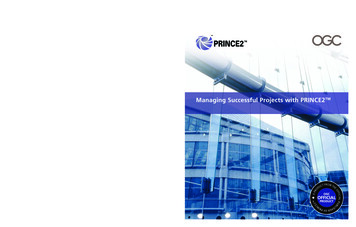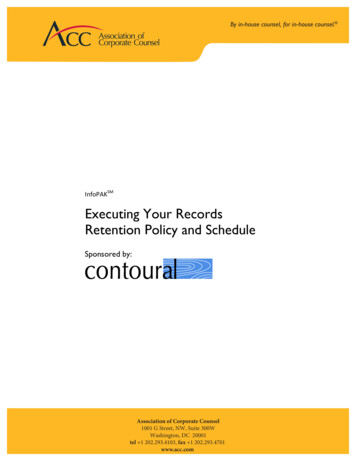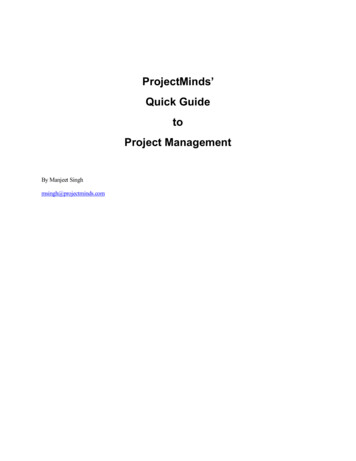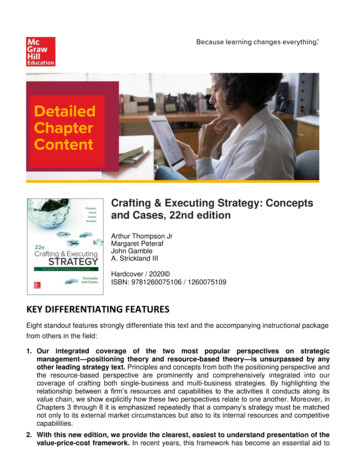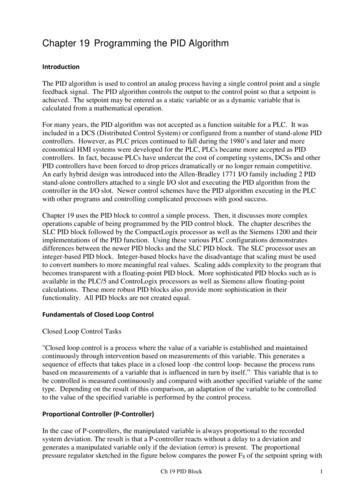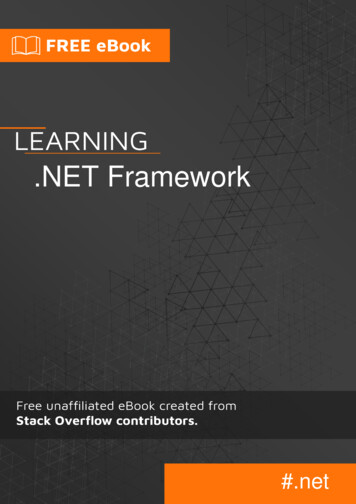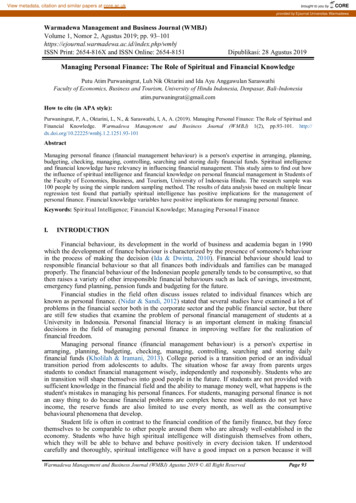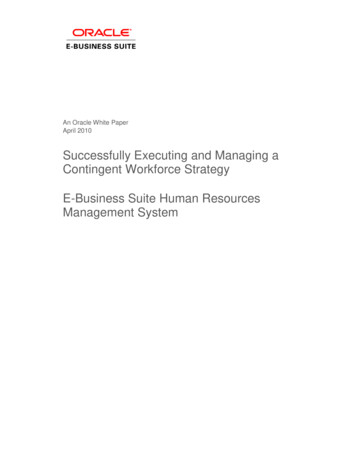
Transcription
An Oracle White PaperApril 2010Successfully Executing and Managing aContingent Workforce StrategyE-Business Suite Human ResourcesManagement System
Successfully Executing and Managing a Contingent Workforce Strategy - E-Business Suite HRMSTable of ContentsIntroduction . 1The Many Aspects of a Contingent Workforce . 2What Are the Benefits of Utilizing a Contingent Workforce? . 5What Are the Risks of Utilizing a Contingent Workforce?. 6How does the Aging Workforce Affect Contingent Labor? . 6Finding the Right Mix of Continent and Traditional Workers . 7Best Practices and Steps in Creating a Contingent WorkforceStrategy . 7Procure the Right Workers . 9Onboard, Provision and Never Lose Sight of Them . 9Train and Engage to Increase Effectiveness. 10Communication is Key . 11Compensate Correctly . 11Remain Compliant at All Times. 11How Oracle Enables a Successful Contingent Workforce . 12Technology Enablers for Best-in-Class Contingent LaborManagement . 13Contingent Worker Functionality in EBS HCM . 14Conclusion . 19Bibliography . 19
Successfully Executing and Managing a Contingent Workforce Strategy - E-Business Suite HRMSIntroductionMastering the management of today’s traditional worker is no simple task. As globalpriorities continue to shift and change, organizations are looking to make strategic financialand human capital decisions – and one of the most prevalent changes is an increased use ofcontingent labor to fill short-term gaps and specific labor segments. In the short term,contingent labor (depending on type) typically does not receive any benefits from theorganization such as health care, and labor taxes are avoided, which can make using this typeof labor attractive to organizations trying to cut labor/headcount costs. Looking forward, aprime motivation for hiring contingents will be a lack of skill/knowledge in the candidatepools of full-time workers. Hard to get skills may only be available fromcontractors/consultants. Generation Y’ers are predicted to make up a big part of thecontingent pool in the next 15 years – their motivation is they want to be their own bosses.So growth of a permanent contingent labor workforce is almost guaranteed, andorganizations need to have processes and systems in place to be able to adequately recruitand manage this workforce. Human resources (HR) practitioners’ overarching responsibilityfor human capital demands that they maintain a keen awareness of the workforce itself,traditional and contingent workers alike.In order to take advantage of contingent labor cost savings and balance the risks you needsolid functionality in your enterprise software (HR, procurement, financials) to manage theseworkers. As you read this paper, you should take note of the business processes and systemsyou currently have in place that will help manage the use of contingent labor and begin toidentify the gaps you will need to fill. Putting a process in place to manage the hiring,training, and managing of contingent labor will allow your organization to meet constantlychanging business demands in the best possible manner.Shifts in the economy, talent shortages in various industries and geographies, and seasonaltalent requirements have accelerated our use of the contingent workforce and it is expectedto increase to 40 percent over the next 10 years. This whitepaper is intended to help thoseorganizations today looking to streamline the processes related to this talent segment.1
Successfully Executing and Managing a Contingent Workforce Strategy - E-Business Suite HRMSThe Many Aspects of a Contingent WorkforceUse of contingent labor requires separate tracking – hiring, training, managing, and eitherexiting or potentially converting to a full time employee – and have different requirementsthan regular employees. There are many legal differences depending on the type ofcontingent hired and each difference must be tracked and managed carefully. Without asolid business process in place, organizations will not be able to take full advantage of thecontingent labor cost savings. Nor will they be able to adequately mitigate the risks thatcome from hiring contingent labor. But from the contingent worker’s perspective, they needto simply be a part of the talent pool, and treated as such, alongside their full-timecounterparts, so the systems must be uniformly applied to the entire workforce.The term “contingent workforce” implies employees who fall outside the norm or whoseemployment is contingent on some additional condition. These are not the classic hourly orsalaried permanent employees working a traditional 35- or 40-hour workweek that qualifiesthem for company benefits. Examination of all possible types of workers outside anorganization’s four walls – temps, contractors and many more – yields a large groupencompassing a broad range of categories which go by many names – temporary, part-time,interns, consultants, contractors, outsourced workers, and offshore workers.1TemporaryemployeesWhen hired through an outside agency, temporary employees bring withthem a management layer that is also contingent.Part-timeemployeesThese might or might not receive benefits, but fall outside the traditionalcategory due to hours per workweek.InternsIn paid and unpaid positions, interns work while receiving on-the-jobtraining for a specified time period in a unique arrangement well outsidethe norm. They may be groomed for future positions within thecompany. College students are a good example of contingents in thiscategory.ConsultantsThis group is typically considered contingent. Usually knowledge-based,they are frequently part of a consulting firm or similar organization.IndependentcontractorsThis group is typically considered contingent. They often work as soleproprietors on an hourly basis.OutsourcedworkersThese employees are paid and managed by a third-party that bills theorganization, which in a sense hires the third-party directly and theemployees indirectly. As with temporary agencies, the third-party itself iscontingent.2
Successfully Executing and Managing a Contingent Workforce Strategy - E-Business Suite HRMSOffshoreworkersIn some cases these might be traditional company employees, but inother cases they are not. Moving employees offshore takes them outsidethe four walls, and offshore status adds a unique communication layer totemporary, part-time, consulting and independent-contractor offshoreworkers. Offshore contingents might be the result of a buy-out, jointventure or partnership.Definitions of the various types of contingent labor that may be employedA recent report by labor law firm Littler Mendelson predicts that contingent labor could riseto as much as 30 to 50 percent of the entire U.S. workforce, triple the average of 13 percentthat a Staffing Industry Analysts survey estimated it to be in 2008. According to Vic Rapierof Examiner.com and Workforce Vision, several notable trends in contingent workforcemanagement are in process including: 2 Nontraditional employment arraignments are on the rise. As has been the trend fordecades contingent labor models are going to increase, however over the next few yearsand coming decades this trend will increase rapidly. Organizations will likely hire temps over permanent workers, especially during times whenan economy is in recovery mode. However, this might also be a long term trend.Temporary workers insulate businesses from fluctuation in demand, and it might be a longwhile until all sectors of the economy stabilize. Contingent labor will become a majorcomponent of the U.S. (and global) labor force. If the future of the economy involves wide use of temporary workers, it is inevitable thatprofessionals will join the ranks of the contingent workforce as well. Contingent labor ismoving from administrative and light industrial positions to being commonplace amongstprofessionals.As organizations increasingly rely on contingent labor, many are finding it a challenge tomanage this critical component of the workforce. Some specific challenges faced byorganizations include confusion in responsibilities between procurement, which is concernedwith price and volume; and HR, which focuses on quality of hire. Moreover, in manyorganizations, individual hiring managers manage their own contingent workforce needs,resulting in multiple, redundant vendor relationships, non-uniform pricing, and tremendousoverall losses in time and money.33
Successfully Executing and Managing a Contingent Workforce Strategy - E-Business Suite HRMSIn a recent study by Staffing Industry Analysts, 73 percent of employers queried anticipatesome level of increase in their contingent workforce by late 2010, with nearly 35 percentplanning increases of 50 percent or more.4Additionally, a recent global study by Manpower, Inc. surveyed more than 41,000 employersin 35 countries and territories. The results reveal that the majority of employers (over six in10) surveyed worldwide do not view contingent workers as being key to their organization’sworkforce strategy. However, a significant 34 percent of employers did respond that thissegment of their workforce was, in fact, an important piece of their overall strategy. Aregional comparison reveals employers in the Americas (48%) most felt contingent workerswere key to their workforce strategy, followed by those in the Asia Pacific (33%) andEurope, Middle East and Africa (EMEA) (23%) regions. In contrast, EMEA employers(75%) most often indicated they did not believe contingent workers to be a critical elementof their strategy, followed by those in the Asia Pacific (58%) and the Americas (50%)regions.54
Successfully Executing and Managing a Contingent Workforce Strategy - E-Business Suite HRMSUse of contingent workers as a key element of workforce strategy – Manpower survey November 2009What Are the Benefits of Utilizing a Contingent Workforce?There are a multitude of benefits to utilizing a contingent workforce. A few of them include: May have faster ramp-up times than individuals completely new to the job or industry, asthey already have many of the skills and experience required. Help reduce the costs associated with recruiting and training new employees due to theirprior experience and reduced ramp-up time. Provide diverse sources of interaction for the knowledge workers on a team. Keepingknowledge workers’ perspectives fresh is an essential competitive weapon. Strengthen an organization’s succession planning efforts by increasing the likelihood thatstaffing can be conducted on a “just-in-time” basis while competitors face shortages. Increase an organization’s ability to attract, retain, and motivate high-performingindividuals who may not otherwise work in a full-time position. Enable an organization to proactively plan for the economic impact of expected talentshortages. As the Baby Boomers leave, replacement costs will likely skyrocket.2 Lower benefit costs, since many contingent workers don’t legally qualify for employerbenefits. Lower employment/payroll taxes5
Successfully Executing and Managing a Contingent Workforce Strategy - E-Business Suite HRMSWhat Are the Risks of Utilizing a Contingent Workforce?Taking on a contingent labor force is not without risks, of course, and each organizationshould thoroughly research and plan to minimize each and every risk. Typical risks include: Worker misclassification, either through negligence or deliberate means, can lead to legalaction. Legal questions about employer offered benefits and workers compensation depending onthe type of worker hired. Non-compliance with governmental taxes, such as payroll taxes. Inadequately executed contracts between either the contracting vendor or the individualworker (independent contractor). Knowledge management – contract workers may be less willing to share their knowledgein order to maintain their contract status. Co-employment – ensuring workers aren’t working for multiple organizations that createlegal conflicts. Animosity from the regular employees that view the contingent worker as possibly gettingbetter work or working conditions.How does the Aging Workforce Affect Contingent Labor?10,000 baby boomers will retire every day for the next 19 years and those who are preboomers got an earlier start. Within a few years, however, many retirees will go back towork. A study done by AARP (American Association of Retired Persons) has estimated thatone-third of the 16.5% of workers age 50 and older eventually go into business forthemselves. 60-90% of retirees will go back to work in some capacity. Because many retireeshave the work ethic and skills that many younger people don t have, many temps find thecompanies want to hire them permanently.6 Many workers that have retired or plan to retireare either faced with a smaller nest egg than anticipated and need to continue to work, orsimply prefer to continue to work part-time in order to stay busy. And with good, solid skillsets, this can be a good talent pool for organizations to consider when shopping forcontingent labor.Additionally, in the United States, the latest labor/job predictions show that there will bemore jobs available to fill by 2018 than there are workers to fill them. This is due in largepart to the reduced population growth in the post-baby boomer generations. Assuming nochange in immigration laws in the U.S., this adds up to 5-6 million unfilled jobs. Thesolution, if this does occur, could easily be to fill them with retired, contingent workers.Good pay and perhaps even modified types of benefits like “grandchild leave” or “extended6
Successfully Executing and Managing a Contingent Workforce Strategy - E-Business Suite HRMSelder care” could entice this group of skilled workers back into the job market.7 It’sreasonable to believe that this same type of trend would be seen in other developedcountries that have declining populations such as most of Europe, Canada, South Africa,Russia, Japan and China.Population growth rate estimates (by United Nations) for the period 2005-2010 using the medium variant.Finding the Right Mix of Continent and Traditional WorkersThe need to engage contingent workers is driven by many factors, most especially fillinghard-to-find skill sets. Obviously, there can be a multitude of reasons to pick a contingentworker over hiring a traditional worker Your internal systems play a major part in thedecision making process. For instance, if you don’t have a solid system for trackingemployee skill sets and goals, you could easily overlook a current employee with skills youneed and hire a contingent instead, possibly costing the organization the loss of that workeror just adding an unnecessary contingent cost. A 2009 study by CedarCrestone also indicatesthat having a robust workforce management system in place (HR and payroll tied to time &labor, absence management and scheduling capabilities) can play a role in optimizing theamount of contingent labor needed simply through better insight into labor costs and laborassignments.8Best Practices and Steps in Creating a Contingent WorkforceStrategyManaging workers who are strategically important to the success of the organization but notnecessarily directly employed is difficult to get right but when done well it can really drivebusiness performance. Best practice strategy is about the organization’s ability to build andmaintain effective employment relationships so that the knowledge contingent workers bring7
Successfully Executing and Managing a Contingent Workforce Strategy - E-Business Suite HRMSis shared with those working for the organization, while ensuring that the organization’svalues and purpose are not diluted. Equally it is important that employment relationships aremanaged to ensure legal compliance and that knowledge key to the organization’s success isprotected.The following section will help highlight best practices and steps for managing theserelationships which: Ensure compliance with often complex legislative requirements regarding contingentworkers that vary by country and region Ensure that the knowledge purchased from external suppliers is managed and retained toinform future activities Recognize the individuals external to their organization who are crucial for success Ensure high standards of delivery across an increasingly complex supply chainThe Contingent Workforce Lifecycle8
Successfully Executing and Managing a Contingent Workforce Strategy - E-Business Suite HRMSProcure the Right WorkersStandardizing enterprise processes as a part of developing a solid contingent workforcestrategy is a best practice in any circumstance and is crucial for contingent workforcemanagement. Decide what types of workers are needed and how they will be tracked andcompensated. Understand the laws affecting the various types of contingent labor you planto procure.A good first step is to establish a collaborative environment for HR, financials andprocurement through use of an integrated system to minimize data entry and risk of noncompliance. Establish working relations with the various departments that will be involvedin the overall process and be sure you each have a full understanding of each other’s rolesand responsibilities. Create service level agreements as needed. Implement and utilizecollaborative Web 2.0 tools such as chat and wikis to bring your groups closer together,share knowledge and ensure processes run smoothly, and in compliance with contingentlaws.Understand the avenues and vendors you plan to use to procure the workers and continuallygauge their performance and quality of workers offered. Organizations typically contractwith either a staffing firm or perhaps directly with an individual. Having servicesprocurement systems in place that are fully integrated with the HR/talent systems, projectmanagement and financials will allow you to create the right relationships withvendors/individuals, create a contract, issue a purchase order, and bring all pertinent workerinformation such as skills and personal details into the recruiting system and prepare you forthe selection process. And analyze their performance over time.Onboard, Provision and Never Lose Sight of ThemOnce you are ready to hire, you need to be able to collaborate with all lines of business to besure the purchase order, budget, job description and contract details are all in alignment.Collaborative workspaces are an ideal way to accomplish this, especially for organizationswhere the required parties are geographically dispersed. All systems should be integrated in afashion that will allow for minimal data entry and be able to set the stage for future trackingof the contingent worker from hire to exit. Having a centralized human resources systemthat is natively integrated with talent management and collaborative functionality as well asprocurement and financial systems is a best practice and will provide the greatest success.The HR system should allow you to build a person profile of the type of worker desired and“fill in the blanks” with specific details once the worker has been procured and you are readyto start moving them into a productive role. Profiles are a collection of selected items suchas competencies, skills, certifications, accomplishments, and so on, that describe thedesirable attributes of a job or organizational entity, or the actual attributes of a person.9
Successfully Executing and Managing a Contingent Workforce Strategy - E-Business Suite HRMSProfiles provide greater insight into talent planning and facilitate more effective managementof existing talent, which can help increase retention and improve morale.With regards to contingent labor, profile management is critical, for example defining a roleof an “executive compensation consultant” who only comes in three months per year tohelp the board determine executive pay and compliance. With profile managementintegrated throughout the HR and talent systems, not only can you search to see if you reallyneed to source externally but you can also track how our own internal capital performsagainst this requirement.Utilizing a HR solution that essentially treats the contingent worker like a regular employeewill also allow you to perform essential provisioning tasks such as security role definitions,badge access and offering benefits when appropriate. Workflow approvals will help secureand streamline all processes and get the contingent worker on site and productive in theshortest possible time.Train and Engage to Increase EffectivenessAs with traditional employees, you are going to want to treat most or all of your contingentlabor with the same type of development techniques and processes in order to ensure theyare producing at the same level as regular workers. Depending on your contract with thesupplier, some of this might be their responsibility but it may also fall to you to ensureconsistency. Items to consider here are conducting performance reviews on the contingentlabor, giving them line of sight information into how their performance aligns with theoverall goals of the organization. Conducting such reviews can give you insight into howwell they are performing and allow an open dialog with the worker and supplier on areas thatneed improvement. From here, you can also identify learning gaps that need to be filled toensure the worker is fully trained and performing at their peak ability.Another area to consider is including these workers in your overall succession planningprocess. While a contingent worker typically doesn’t stay with an organization for a longtime, there is a shift towards more non-permanent workers as discussed previously, and itwould make sense to start including at least the key performers in succession plans in theevent they either convert to permanent employees at some point, or continue on to fill otherroles in the organization. Studies conducted by CedarCrestone have shown that conductingsuccession planning at all levels of the organization yields a much higher level of overall salesgrowth than merely conducting succession planning on executive management or keyplayers.9Consider work-style needs for contingent labor. Many may not be full-time, or traditional 95 workers. Be prepared to be flexible in work schedules, job-sharing, and remote workenvironments. And lastly, contingent worker training can also help contribute to a saferworking environment.10
Successfully Executing and Managing a Contingent Workforce Strategy - E-Business Suite HRMSCommunication is KeyIt will come as no surprise that communication will be key for success in a contingentworkforce strategy, both for the contingent worker and the traditional workers, andmanagement. Contingent labor may tend to feel more or less valuable than regularemployees. They may tend to feel they are considered separate from regular employees,given extra work, or simply not part of the overall team. On the other hand, traditionalemployees may tend to feel animosity towards contingent labor if they feel that thecontingent worker is being compensated better, has more flexibility with work hours andassignments, or that work is being taken away from them. Best-in-class organizations willplan for this and utilize tools and processes to be sure the entire workforce understands theirroles and organizational goals and will create an overall team environment that isharmonious.Best practices in employee communication include the ability to created targeted messages tospecific groups or individuals; gather feedback in a 360º environment; and survey employeesto gain valuable insight into wants and needs.Compensate CorrectlyCompensation with contingent labor can be a tricky area to navigate. On one hand, you havenegotiated what is hopefully a fair and equitable price when procuring their labor. On theother hand, if you are tracking their performance and potential to help your organizationmeet its goals, it is reasonable to assume that discussions could be had for over- andunderperforming resources. Additionally, you have a number of different types ofcontingent labor that could be in your employ (contractors, temps, interns, and so on) andeach will carry a certain amount of legal and tax implications to consider as you move intothe area of compensation. From a system standpoint, you need to be prepared, againthrough integrated systems, to be able to provide timely and accurate compensation eitherthrough the accounts payable system in financials or directly through the payroll system inHR. While most contingent workers would be paid through accounts payable, certain typesmay need to be paid through payroll, such as part-time employees, and interns. Accuratecoding, reporting and analysis is critical here.Remain Compliant at All TimesCompliance is one of the most confusing and complicated areas to maneuver when usingcontingent labor since there are so many varieties that might be employed. Be sure youresearch this well and consult your internal legal department to understand all thecompliance issues that will be required.From the systems standpoint, there are three key components you want to be sure are inplace.11
Successfully Executing and Managing a Contingent Workforce Strategy - E-Business Suite HRMS1. Consistent classification of contingent status – standardization of all contingentlabor processes and classifications is a best practice and will significantly reduce therisk associated with managing a contingent workforce.2. Reporting (Statutory and internal management) – this is critical to reducing risk ofaudits or lawsuits, and will help keep costs in line or be able to reduce them throughbetter line of sight between the costs and worker performance.3. KPIs – Key Performance Indicators will provide on the spot insight into workerperformance and vendor performance, and help ensure the best workers areprocured at the best price.Although most organizations spend a large share of total budget on services, few have thesame visibility into service costs as they do for goods and materials. Workforce analytics,including data warehousing, will be crucial in order to aggregate data across financials,procurement and HR and both prove the value of contingent labor at an executive level andhelp organizations manage costs.How Oracle Enables a Successful Contingent WorkforceOracle’s E-Business Suite HRMS and PeopleSoft HCM systems both offer processes andfunctionality to support a robust contingent workforce management strategy. And in somecountries and industries, a shift towards utilizing a permanent temporary workforce isbeginning to take shape, which makes being able to manage contingent labor even morecritical. No matter which Oracle HCM system you are using or plan to use, employees andcontingent labor co-exist in all our core business processes. Oracle’s HCM systems offereasy defining, tracking and updating of contingent worker data such as: Management of contingent worker assignments. Succession planning can be conducted for a both contingent labor and employees alike. Job openings can be filled with contingent labor by matching skills to job openings andintegration between procurement and recruiting. Contingent worker data resides in delivered reports. Contingent labor can be paid directly through payroll or through accounts payable if theworker is requisitioned through a purchase order. Integration between procurement and recruiting. Analyze the success of both the worker and the supplier.12
Successfully Executing and Managing a Contingent Workforce Strategy - E-Business Suite HRMSTechnology Enablers for Best-in-Class Contingent Labor ManagementHCMSCMFMSCore HRVendor MgmtGeneral LedgerPayrollProcurementAccounts PayableTime and LaborContract MgmtProject MgmtAbsence/SchedulingServices MgmtCRMSocial Tools forcommunication,collaboration andengagementTalent MgmtWorkforce Planningand OptimizationGovernance, Risk & ComplianceWorkforce Analytics - Dashboards/KPIs/Data Warehousing13
Successfully Executing and Managing a Contingent Workforce Strategy - E-Business Suite HRMSContingent Worker Functionality in EBS HCMThe tables below highlight some of the capabilities and technology enables in E-BusinessSuite HCM that support contingent workforce business processes.Procure the Right WorkersBusiness ProcessCapabilitiesTechnical EnablerEstablish acollaborative workenvironmentEnsure HR, Finance and Purchasingare working together on the overallcontingent strategyService levelagreements betweendepartments and/orsocial media toolsEstablish a budgetfor contingentworkersCreate a tracking strategy betweenHR's ability to track hours worked andthe established budgetTime & LaborServices ProcurementBudgeting/FinancialManagementCreate a PurchaseOrderManage the procurement of contingentlabor using Oracle ServicesProcurement. In this case, contingentlabor or their managers can enter timecards using Oracle Time and Labor(OTL) and generate payment invoicesautomatically.Purchasing,Oracle ServicesProcurementPost a job openingContingent labor can be hired using„Enter and Maintain‟ form or using“Contingent worker placem
to as much as 30 to 50 percent of the entire U.S. workforce, triple the average of 13 percent that a Staffing Industry Analysts survey estimated it to be in 2008. According to Vic Rapier of Examiner.com and Workforce Vision, several notable trends in contingent workforce management are in process including: 2

